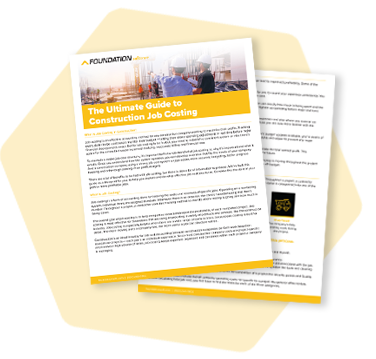
It’s no secret that payroll costs represent the single largest operating expense for most contractors. What’s surprising, though, is that so many contractors struggle to manage their payroll—and their job costs—when construction-specific software technology can make easy work of this increasingly complex process.
Whether a construction business is considering new construction accounting software or simply evaluating its current accounting system, contractors should consider 10 major features and capabilities to help in automating and streamlining payroll.
1. Timecard Entry
When it comes to payroll timecard entry, contractors need a flexible system. Construction companies vary greatly in how they collect payroll data (paper, spreadsheets or remote timecard systems), what kind of data they collect (by crew, job, employee or a combination), and how the information is transmitted to the office (via fax, phone, the Internet or intranet). Therefore, construction payroll software should support unlimited timecard styles and methods, and it should seamlessly integrate with third-party timecard applications.
Some construction-specific systems offer their own timecard designs with pre-defined defaults and protected fields to help prevent errors and save time. In addition, good construction payroll software provides proofing reports as well as equipment and production tracking from timecard entries.
2. Multi-State, Multi-Locality and Multi-Job Processing
In a single payroll run, it’s not uncommon for construction employees to work on a number of jobs in multiple states and localities. They also may perform work under various trade classifications or receive different pay rates—all on a single timecard. As a result, a must-have payroll feature for many contractors is the ability to automatically compute different tax rates and deductions, as well as changing pay rates, depending on job location. The ability to assign an employee’s time to multiple jobs and phases, along with automatic calculations of various deductions, is not only a huge time saver for payroll personnel, but it ultimately leads to a greater understanding of how and where labor job costs are spent.
3. Job Cost and General Ledger Integration
If contractors hope to track and manage their job costs effectively, they need a system that integrates payroll with general ledger and job costing modules. Good construction accounting software assigns a job number to every labor and employer burden dollar so data can be pulled from either general ledger or job costing by job.
The integration of payroll data into the general ledger software can lead to another advantage: overhead allocation. Not only should the system track labor dollars and the standard employer burden (FICA, FUTA, SUTA, workers’ compensation), but it also should be flexible enough to allocate company-specific burdens, such as company-paid health insurance or paid vacation/holiday time. With the ability to define and track these expenses and then automatically allocate payroll-related overhead expenses to jobs, contractors can more closely determine the net profit (rather than gross profit) of each job.
4. Certified Payroll
The inability to produce certified payroll reports, such as prevailing wage and statement of compliance, can become a major roadblock that prevents open shop contractors from competing for government funded jobs. Most construction-specific accounting systems should be able to instantly produce these reports for any payroll period. The sign of a good certified payroll feature is the ability to re-run a report from prior periods, even after the correction of errors or omissions.
Also important with regard to prevailing wage jobs is a software product’s ability to allocate and accrue fringe benefits for employees. For example, a feature referred to as the “fringe benefit reduction factor” can automatically credit the company for existing non-cash fringe benefits paid on the employees’ behalf, thereby reducing the fringe portion of the prevailing wage rate by the cost of current fringe benefits. This feature not only makes it easier for contractors to comply, but it also saves them money by helping them avoid paying the fringe portion of prevailing wage in cash.
5. EEO And Benefit / Deduction Reporting
In addition to certified payroll reports, many contractors need help with the burdensome work of preparing detailed reports—in precise formats—for other government agencies. The manual preparation of Equal Employment Opportunity reports (which are required to bid on or comply with government funded jobs) can be eliminated with a construction-specific program that instantly generates reports detailing the total number of employees on a job, the number of minority workers on a job and the number of minority hours worked within a specific period.
A good construction payroll system also features a generous number of user-defined deductions that allow for instant computation of liability insurance, garnishments, employee loans and 401(k) deductions. Again, flexibility is key. A construction specific payroll system should allow users to define not only how their deductions are calculated (hourly, with or without overtime factors, percent of gross, fixed amounts or based on trade classifications), but also when (weekly, concurrent, one-time, recurring) and where (multiple state/job classifications).
6. Date-Sensitive / Historical Reporting
Many accounting systems—particularly outdated applications—use a hard close system designed to prevent users from posting data in periods that have been reconciled. Unfortunately, a hard close system also prevents users from reconstructing historical reports or accessing past payroll data on the fly.
In contrast, date-sensitive systems allow users to pull data from any time period— even data from past years or that crosses calendar and fiscal year boundaries. That means, for example, that a payroll administrator could instantly create an employee job history report for an 18-month period. This is a powerful tool for both internal and external audits, as well as for employee and job analysis.
7. Standard Payroll Reports
Aside from timecard proofing and pre-check reports, certified payroll reports and minority compliance reports, contractors should consider the other types of reporting they may need from their payroll software. For example, unless payroll is handled by an outside service, the software should be capable of generating various federal and state payroll tax reports, including year-end W-2 forms (both printed and magnetic). Finally, how easily can the software generate timecard history, detailed job reports and accrued time off?
8. Security Controls
As the repository for sensitive salary information, a contractor’s payroll software should contain security controls that guarantee both confidentiality and transparency. Examples of security features include: the ability to control which users can access data at various pay levels, the option to create and assign an unlimited number of user IDs and passwords, and easy-to-follow audit trails that detail every element of change (e.g., user, date, time, transaction type and old versus new values).
9. Direct Deposit
Direct deposit is a payroll feature contractors cannot afford to be without. Not only do employees value the convenience, but contractors can save money, avoid risk of fraud and increase payroll department productivity all at once. Unfortunately, not all payroll software supports Automated Clearing House direct deposit capabilities, which allow the software to produce a file that can be sent to the bank
10. Distinguish Between Costs
Often, a construction company employee who typically works in the field also logs a few hours in the shop or office. A good construction payroll system must be able to handle the general ledger ramifications of an employee moving from the field (direct costs) to the shop (indirect costs) or office (general and administrative labor costs).
With all of its complexities, construction payroll can be painstaking and time-consuming. Fortunately, many construction- specific applications today offer extensive payroll features to help automate much of the process and alleviate many of the risks.
*Published in Construction Executive
Share Article
Keep on current news in the construction industry. Subscribe to free eNews!
Learn about our software more in depth with product overviews, demos, and much more!

Our ACA reporting & e-filing services include official 1094-C and 1095-C IRS reporting, optional e-filing (no applying for a TCC code required), mailing to your employees and experienced support to help you.

There are plenty of reasons to make FOUNDATION your choice for job cost accounting and construction management software — just ask our clients!

From job cost accounting software, to construction-specific payroll. Get an overview on your next all-in-one back-office solution.



